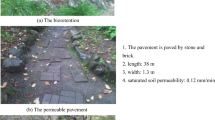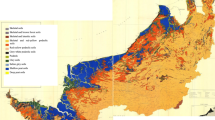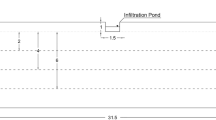Abstract
With the increasing effect of urbanization becoming more apparent through flooding and decline in downstream water quality especially from heavy rainfalls, stormwater runoff management solutions have focused on treatment and infiltration. However, there are areas with low infiltration soils or are experiencing more dry days and even drought. In this study, experiments were conducted to compare the applicability of high infiltration and low infiltration soils as a base layer in gravel-filled infiltration systems with emphasis on runoff capture and suspended solids removal. Findings showed that infiltration rates increased with the water depth above the gravel-soil interface indicating the available depth for water storage affects this parameter. Runoff capture in high infiltration systems are more affected by rainfall depth and inflow rates as compared to low infiltration systems. Based on runoff capture and pollutant removal analysis, a media depth of 0.4 − 1 m and maximum infiltration rate of 200 mm/h were recommended. Moreover, it was revealed that low infiltration systems are more susceptible to horizontal flow and that the length of the structure may be more critical than depth in this condition.
Similar content being viewed by others
Abbreviations
- A :
-
catchment area, m2
- a :
-
facility surface area, m2
- C :
-
runoff coefficient
- d m :
-
depth of the media, m
- e :
-
void ratio of the media
- f d :
-
infiltration capacity of the soil media, mm/h
- Pd :
-
design rainfall, mm
- td :
-
drawdown or emptying time, h
- VS :
-
water quality storage volume, m3
References
AECOM (2013) Model standards & specifications for low impact development practices. City of Riverbank, Riverbank, CA, USA, 22–23
Akram F, Rasul MG, Khan MMK, Amir MSII (2014) A review on stormwater harvesting and reuse. International Journal of Environmental,Ecological, Geological and Mining Engineering 8(3):188–197, DOI: 10.5281/zenodo.1091578
APHA, AWWA, and WEF (1995) Standard methods for the examination of water and wastewater, 19th edition. American Public Health Association/American Water Works Association/Water Environment Federation, Washington, DC, USA, 2–56
ASTM D698-12e2 (2012) Standard test methods for laboratory compactioncharacteristics of soil using standard effort (12 400 ft-lbf/ft3 (600 kN-m/m3)). ASTM D698-12e2, ASTM International, West Conshoshocken, PA, USA
Begum S, Rasul MG, Brown RJ (2008) Stormwater treatment and reuse techniques: A review. Proceedings of 2nd international conference on waste management, water pollution, air pollution, indoor climate, October 26–28, Corfu, Greece
Bouwer H, Rice RC (1989) Effect of water depth in groundwater recharge basins on infiltration. Journal of Irrigation and Drainage Engineering 115(4):556–567, DOI: 10.1061/(ASCE)0733-9437(1989)115:4(556)
COPES (2004) Stormwater solutions handbook. City of Portland Environmental Services, City of Portland, OR, USA, 30–33
Davis AP, Shokouhian M, Sharma H, Minami C, Winogradoff D (2003) Water quality improvement through bioretention: Lead, copper and zinc removal. Water Environment Research 75(1):73–82, DOI: 10.2175/106143003x140854
Feng GL, Letey J, Wu L (2001) Water ponding depths affect temporal infiltration rates in a water-repellant sand. Soil Science Society of America Journal 65(2):315–320, DOI: 10.2136/sssaj2001.652315x
Hunt WF, Lord WG (2006) Urban waterways. Report AGW-588-05, North Carolina Cooperative Extension Service, Raleigh, NC, USA
KEC, MOE (2013) Guidelines for low impact development (LID) technology element. Korean Environment Corporation and Korean Ministry of Environment, Korean Ministry of Environment, Sejong, 66–87
Kim HK, Jeong HS, Jeon JH, Bae SJ (2016) The impact of impervious surface on water quality and its threshold in Korea. Water 8(4):111–119, DOI: 10.3390/w8040111
LADPW (2014) Low impact development standards manual. Los Angeles Department of Public Works, County of Los Angeles, CA, USA, E1-E32
Li H, Davis AP (2008) Heavy metal capture and accumulation in bioretention media. Environmental Science and Technology 42(14):5247–5253, DOI: 10.1021/es702681j
Moscrip AL, Montgomery DR (1997) Urbanization, flood frequency and salmon abundance in Puget Lowland streams. Journal of the American Water Resources Association 33(6):1289–1297, DOI: 10.1111/j.1752-1688.1997.tb03553.x
O’Brien, Company LLC (2009) Low impact development (LID) guidance manual. A practical guide to LID implementation in Kitsap county. Kitsap Home Builders Foundation, Kitsap, WA, USA, 362–365
Shuster WD, Bonta J, Thurston H, Warnemuende E, Smith DR (2005) Impacts of impervious surface on watershed hydrology: A review. Urban Water Journal 2(4):263–275, DOI: 10.1080/15730620500386529
Tetra Tech, Inc. (2011) San diego low impact development design manual. City of San Diego Storm Water, San Diego, CA, USA, 1–32, 48
USEPA (2000) Low impact development (LID): A literature review.Report EPA-841-B-00-005, US Environmental Protection Agency Office of Water, Washington, DC, USA
USEPA (2001) Our built and natural environments: a technical review of the interactions between land use, transportation, and environmental quality. US Environmental Protection Agency, Washington, DC, USA, 1–4
USGS (1999) The quality of our nation’s waters-nutrients and pesticides. Circular 1225, U.S. Department of Interior, U.S. Geological Survey, USGS Information Services, Reston, VA, USA
Virginia Tech (2013) BMP design manual of practice. Virginia Department of Transportation, Richmond, VA, USA, 1–14
Willardson B, Walden A (2004) Analysis of 85th percentile 24-hour rainfall depth analysis within the county of Los Angeles. Report, Department of Public Works, County of Los Angeles, CA, USA
Yu G, Choi J, Kang HM, Kim LH (2016) Evaluation of the volume and pollutant reduction in an infiltration and filtration facility with varying rainfall conditions. Journal of Korean Society on Water Environment 32(1):30–35, DOI: 10.15681/KSWE.2016.32.1.30
Acknowledgements
This research was supported by a grant (2016000200002) from Public Welfare Technology Development Program funded by the Korean Ministry of Environment.
Author information
Authors and Affiliations
Corresponding author
Rights and permissions
About this article
Cite this article
Guerra, H.B., Kim, Y. Understanding the Performance and Applicability of Low Impact Development Structures under Varying Infiltration Rates. KSCE J Civ Eng 24, 1430–1438 (2020). https://doi.org/10.1007/s12205-020-2274-5
Received:
Accepted:
Published:
Issue Date:
DOI: https://doi.org/10.1007/s12205-020-2274-5




